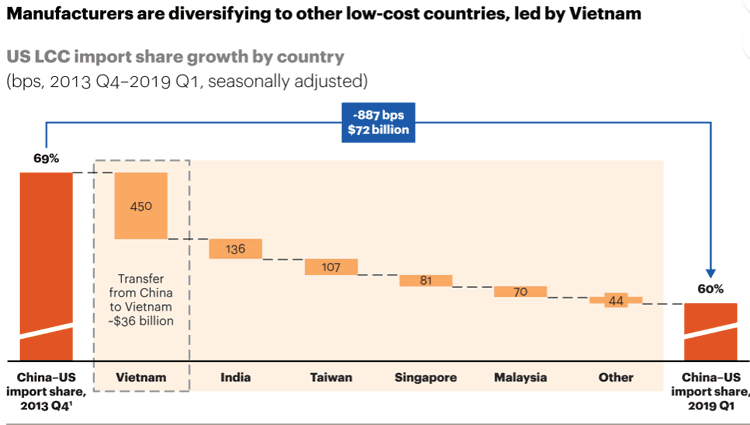If the goal of US tariffs on Chinese imports was to bolster US manufacturing, it doesn't seem to be working.
The latest annual report from the consultants at AT Kearney, released last week, finds that the growth in manufactured goods imports into the United States from the 14 largest low-cost country (LCC) trading partners in Asia rose by $66 billion or 9% for 2018, the largest annual increase since the beginning of the economic recovery.
Supply Chain Digest Says... |
|
|
US gross manufacturing output, by comparison, grew a lower 6% year-over-year in 2018.
As a result, the Kearney Reshoring Index decreased for the third year in a row, by 32 basis points (bps), indicating that manufacturers continue to view LCCs as a more desirable location than the US to produce or purchase a wide variety of goods, notwithstanding the trade measures emanating from Washington, DC.
The index is calculated by first taking level of importsof manufactured goods from 14 traditional offshore trading partners: China, Taiwan, Malaysia, India, Vietnam, Thailand, Indonesia, Singapore, Philippines, Bangladesh, Pakistan, Hong Kong, Sri Lanka, and Cambodia. Kearney that looks at the US domestic gross output of manufactured goods.
Using those two numbers, Kearney calculates what it calls the manufacturing import ratio (MIR), which is calculated by dividing the first number by the second. The US Reshoring Index is the year-over-year change in the MIR, expressed in basis points (100 basis points equals 1%). A positive number indicates net reshoring, or a growth in gross domestic output that exceeded the growth of imports from the 14 LCCs.
In 2018, imports of manufactured goods from offshore trading partners reached $816 billion. US domestic gross output of manufactured goods reached $6,249 billion in 2018. As a result, the manufacturing import ratio for 2018 is 13.1%, meaninge there were 13.1 cents worth of offshore production bound for the US market for every $1 of domestic manufacturing gross output.
That, it turns out, is highest MIR since Kearney began tracking the Reshoring Index, and continues a trend of five years of consecutive growth in the MIR. So, the Kearney data shows production imports from Asia are growing much faster than US domestic production.
However, China does continue to lose its share of exports among the 14 countries, as shown in the chart below. China's 69% share of imports into the US in late 2014 has fallen to 60% currently. Vietnam has is largest beneficiary of that decline, as shown in the chart.

Source: AT Kearney
So why haven't America's new trade and tax policies resulted in an uptick in reshoring?
(See More Below)
|
CATEGORY SPONSOR: SOFTEON |
|
|
|
|
|
"For starters, the fundamental economic benefits of manufacturing in low-cost countries vs. the US have not significantly changed, and the FDII tax benefits have not outweighed the still significantly lower unit costs to manufacture offshored products," Kearney observes.
And Kearney says that when manufacturers do consider bringing production back to North America, they often opt to "nearshore," particularly to Mexico.
Kearney says "This trend has picked up considerable momentum in the past year, in large part due to US–China tensions, as well as to progress on the United States– Mexico–Canada Agreement (USMCA)."
"The trade war has not supported reshoring," said Johan Gott, a principal at AT Kearney and a co-author of the report.
"What we do see is a sort of China diversification," Gott adds, noting companies look to reduce their exposure to trade tensions, rising Chinese labor costs and other risks by moving sourcing to other Asian countries – not to US soil.
If China tariffs aren't getting the job done, what to do?
"The overarching US policy objective should be to bolster US manufacturing competitiveness for those high-value sectors where onshore production does make sense," Kearney recommends.
The full report is available here: The Real Impact of America's New Trade Policies
Any reaction to this AT Kearney report? Let us know your thoughts at the Feedback section below.
Your Comments/Feedback
|